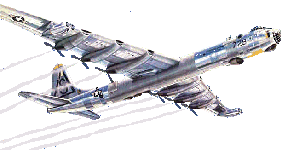The Songs They Sang: Battle Hymn
About the wild blue yonder, and the days when men were strong
But now we're regulated 'cause we don't know right from wrong
The force is shot to hell!
Glory, flying regulations
Have them read at all the stations
Crucify the man who breaks one,
The force is shot to hell!
For this final installment in our series, let’s turn our attention to a specific tune rather than the subject of the songs. Specifically, let's take a look at the aviation songs that stem from that old American standard, "The Battle Hymn of the Republic."
While "Battle Hymn" is inextricably linked to the Civil War, the
tune itself comes from a spiritual written five years before the
war started. As the Federal forces began to assemble, the
song emerged as "John Brown's Body." It was originally
written to tease a young Scotsman by that name in a
Massachusetts regiment. But as its popularity grew, new
lyrics referenced the famed abolitionist, executed just prior to
the war.
Most histories say that Julia Ward Howe heard the song sung in a
military camp, and was inspired to write a new set of lyrics in
support of the Union cause.
Others have a slightly different explanation: The
soldiers' bawdy lyrics so scandalized Mrs. Howe that she wrote a
set of "clean" verses to go with the popular tune.
In any case, the music of "Battle Hymn" has been hijacked
countless times since, for songs both clean and bawdy, from the
Boy Scouts to the Rangers, and from the potato-peelers to the
pilots.
Why the attraction? First, it's a tune everyone
knows. When folks know the music that well, writing new
lyrics for it is relatively easy.
Plus, the chorus is easy... “John Brown’s Body” repeats the
first line three times (“Glory, glory, hallelujah”), so plugging
in one's own chorus is easier. Plus...well, if they repeat
lines in the chorus, why not in the main lyrics?
 The B-36 it flies at 40,000 feet,
The B-36 it flies at 40,000 feet,The B-36 it flies at 40,000 feet,
The B-36 it flies at 40,000 feet,
But it only drops a teensy-weensy bomb!
Tons and tons of ammunition,
Tons and tons of ammunition,
Tons and tons of ammunition,
But it only drops a teensy-weensy bomb!
One famous flying song uses most of the tune...but abandons it
on the last verse:
You can tell a bomber pilot by the spread around his rear,
You can tell a navigator by his charts and maps and such,
You can tell a fighter pilot...but you cannot tell him much!
My references show at least three more songs set to the
tune. One isn't really flying-oriented (being about a
young woman digging clams), another is written from the point of
view of a North Vietnamese anti-aircraft gunner during an F-105
strike ("Battle Hymn of the 85mm Gunner").
The last of the three is probably the most famous of the
aviation songs using "Battle Hymn", but it isn't about pilots,
either. It’s the famous song of the airborne troops,
"Blood Upon the Risers”:
He checked off his equipment and made sure his pack was tight.
He had to sit and listen to those awful engines roar:
“You ain't gonna jump no more!”
Gory, gory, what a hellava way to die.
Gory, gory, what a horrible way to fly.
Gory, gory, what a hellava way to die.
And he ain't gonna jump no more!
The song tells of the rookie’s first parachute jump.
Unsurprisingly, it does not end well.
I own four different recordings of "Blood Upon the
Risers." The version that really stands out was recorded
by the West Point Glee Club. They take a different
approach: They sing it perfectly seriously, as if it were
the original "Battle Hymn of the Republic." Joining in
a-cappella harmony to sing the "punch line" as solemnly as if
they were standing in church:
Intestines were a-dangling from his paratrooper suit.
He was a mess, they picked him up and poured him from his boot.
And he ain't gonna jump no more!
Like many of the songs sang by pilots, it parodies the dangers
feared the most. But "The Air Corps Lament," the song that
began this article, brings the concept full-circle. It's a
song of peace, not of war. A song for an era where the
biggest threat the pilot faces is a stern-faced senior officer
calling them on the carpet.
It speaks of the boredom of peacetime—but pays tribute to the
sacrifices of combat pilots...
And bloody dying pilots gave their lives to bring them back
But now they're playing ping-pong in the operations shack
The force is shot to hell!
...but like many of the songs they sang, it
ends on a note of hope. A twisted note of hope, but when
pilots are singing, one has to take what one can get:
Tear them down at every station
Burn the guy who tries to make one
AND LET'S ALL FLY LIKE HELL!
For more Information:
- The West Point Glee Club's acapella version of "Blood upon the Risers"
- "Blood on the Risers" from Hank Cramer's, "A Soldier's Songs". You can download this song itself, or listen the to the Sample. Note: This is an outstanding CD. It covers about four hundred years of the music sung by the everyday soldier.
Questions? Email Ron Wanttaja .

